#AI-driven Construction
Explore tagged Tumblr posts
Text
Can AI Revolutionize 3D Concrete Printing? Exploring the Future of Construction
Introduction The field of construction is undergoing a transformative revolution with the advent of 3D concrete printing technology. This cutting-edge approach promises faster, cost-effective, and eco-friendly construction, revolutionizing the way we build structures. Now, the convergence of artificial intelligence (AI) with 3D concrete printing is pushing the boundaries even further, introducing…

View On WordPress
#3D Concrete Printing#Additive Manufacturing#AI#AI integration#AI-driven Construction#Architecture#artificial intelligence#Building Efficiency#Collaborative Robotics#construction#Construction Automation#construction industry#Construction Revolution#Construction Trends#Cost of Implementation#Data Privacy#Design Optimization#Eco-friendly Construction#future of construction#innovation#Material Selection#Predictive Maintenance#quality control#Real-Time Monitoring#Regulatory Compliance#Robotics#Security#Smart Robotic Systems#Sustainable Building#Sustainable Construction
0 notes
Text
Smart Building Technologies: AI & IoT Solutions for Modern Construction
Explore how smart building technologies are revolutionizing the construction industry in Philadelphia. With AI in construction management and IoT in building automation, companies are enhancing efficiency, safety, and sustainability in every phase of a project. Discover how AI-driven construction safety solutions are helping to prevent accidents and improve decision-making on-site. From high-rise developments to smart infrastructure, these innovations are shaping the future of urban building. Learn how adopting smart building technologies can future-proof your projects and ensure compliance with modern standards in one of America's most competitive construction markets.
#smart building technologies in Philadelphia construction#AI in construction management in Philadelphia#IoT in building automation systems Philadelphia#AI-driven construction safety tools in Philadelphia#Philadelphia smart construction technologies#advanced IoT solutions for building automation Philadelphia#artificial intelligence in Philadelphia building projects#construction safety technology for Philadelphia contractors#smart infrastructure development in Philadelphia#energy-efficient smart buildings using AI and IoT Philadelphia
0 notes
Text
Explore how construction companies are using AI, machine learning, and mobile apps to streamline processes, enhance safety, and improve project outcomes. Learn how TucsonBizz is helping revolutionize the construction industry with advanced technology solutions.
#Construction Companies#Artificial Intelligence#AI-driven Mobile Apps#AI#Mobile App development#Mobile Application Development#Construction Industry#Construction Sector
0 notes
Text
AI in BIM: Paving the Way for Smarter Construction Projects

The construction industry, traditionally known for manual labor and on-site work, is undergoing a digital revolution. Among the transformative technologies leading this shift is Building Information Modeling (BIM), a process that has redefined project planning, design, and management. Now, with the integration of Artificial Intelligence (AI), BIM is entering a new phase, poised to reshape the future of construction with unprecedented levels of efficiency, accuracy, and innovation.
In this blog post, we'll explore how AI-driven BIM modeling is shaping the future of construction, its impact on various phases of project development, and what it means for stakeholders across the industry.
1. Enhanced Design Automation
AI’s role in BIM is revolutionizing how architects and engineers design buildings. Traditionally, designers had to manually create complex 3D models, but AI-driven BIM modeling automates many aspects of the design process. AI algorithms can generate designs based on preset parameters, making it easier to explore multiple design options and scenarios.
Through generative design, a subfield of AI, engineers can input constraints like materials, budgets, and environmental considerations into BIM software, and the AI will generate a wide range of optimized design solutions. This process saves time and helps identify the most efficient, sustainable, and cost-effective design options for construction projects.
2. AI-Enhanced Collaboration and Coordination
Construction projects involve numerous stakeholders: architects, engineers, contractors, and owners. Effective collaboration between these parties is critical to the success of any project. AI-driven BIM enhances collaboration by facilitating seamless integration and real-time coordination.
With AI, BIM platforms can analyze and predict potential clashes between different disciplines before construction even begins. For instance, AI algorithms can cross-check architectural designs against structural engineering models to ensure that everything fits together without conflicts. This early clash detection helps avoid costly delays and revisions during the construction phase.
Moreover, AI-powered BIM systems can send automated updates and alerts to all team members, ensuring that everyone is on the same page. Real-time feedback loops also enable quicker decision-making, keeping the project on track and under budget.
3. Risk Mitigation and Safety Improvement
Safety is a major concern in construction, and AI-driven BIM modeling is playing a key role in improving on-site safety. AI can analyze historical data from previous projects to predict potential risks in current and future construction sites.
For example, AI algorithms can review data related to worker behavior, equipment usage, and environmental conditions to identify patterns that could lead to accidents. By integrating this data with BIM models, AI can create simulations that highlight potential hazards before they occur.
In addition, AI-powered BIM can help in scheduling construction tasks more effectively. By analyzing timelines and construction site conditions, AI can recommend the safest sequence of operations, reducing the risk of accidents and improving overall safety outcomes.
4. Predictive Maintenance and Facility Management
Beyond the construction phase, AI-driven BIM plays an essential role in facility management and predictive maintenance. Once a building is operational, AI can continuously monitor the structure using sensors and IoT devices integrated with the BIM model.
AI can predict when maintenance is required by analyzing data related to the wear and tear of building materials, mechanical systems, and environmental factors like humidity and temperature. This predictive maintenance capability helps facility managers address issues before they become costly repairs, extending the lifespan of the building and improving its overall efficiency.
Additionally, AI can analyze energy usage patterns within a building and suggest optimizations for reducing energy consumption. This not only results in significant cost savings but also supports sustainable construction practices by minimizing the building's carbon footprint.
5. Optimized Construction Scheduling and Resource Management
Time is a critical factor in construction projects, and delays can lead to budget overruns. AI-driven BIM modeling significantly enhances the construction scheduling process by automating the development of construction timelines based on the analysis of previous projects, real-time data, and available resources.
AI algorithms can also optimize the allocation of materials and labor. By analyzing data related to material usage, workforce availability, and equipment requirements, AI can recommend the best way to schedule deliveries, deploy workers, and utilize equipment on-site. This level of precision reduces waste, minimizes downtime, and keeps the project on schedule.
Furthermore, AI can continuously update the construction schedule as new data becomes available, ensuring that the project adapts to changes in real-time. Whether it's weather disruptions, supply chain issues, or other unforeseen events, AI-driven BIM systems can help adjust schedules and resource allocations to keep the project moving forward.
6. Sustainability and Environmental Impact Reduction
Sustainability is increasingly a priority for the construction industry. AI-driven BIM modeling can significantly contribute to more sustainable construction practices. By integrating AI, BIM can simulate various design and construction scenarios to determine their environmental impact, from energy consumption to the carbon footprint.
AI can analyze building materials, design features, and construction methods to identify the most eco-friendly options. For example, AI can suggest materials with lower environmental impact, optimize building orientation for energy efficiency, and recommend sustainable construction practices.
In the long run, AI-powered BIM helps the industry achieve sustainability goals by designing and constructing buildings that are more energy-efficient, use fewer resources, and have lower operational costs.
7. Real-Time Data Analytics and Informed Decision-Making
One of the most powerful aspects of AI-driven BIM is the ability to collect and analyze vast amounts of data in real time. From design inception to post-construction, AI can process data from various sources—such as sensors, cameras, and IoT devices—to provide actionable insights at every stage of the project lifecycle.
These insights enable construction managers and project stakeholders to make more informed decisions. For example, AI can analyze labor productivity data to optimize workforce deployment or assess material supply chain data to minimize procurement delays.
By leveraging real-time data, AI-powered BIM systems provide valuable foresight into potential challenges, enabling proactive decision-making that keeps projects on track and within budget.
8. AI and the Future of Smart Cities
As the world moves toward the development of smart cities, AI-driven BIM modeling will be a crucial element in their realization. Smart cities require interconnected infrastructure, seamless energy management, and optimized transportation systems—all of which can be modeled, simulated, and optimized through AI-powered BIM platforms.
AI-driven BIM can model entire city infrastructures, enabling urban planners to simulate and test different urban design scenarios. AI can assess the impact of various factors like traffic flow, energy consumption, and environmental conditions, enabling smarter, more sustainable urban planning decisions.
As smart cities continue to evolve, AI-driven BIM will play an integral role in shaping their future by creating data-rich models that optimize urban infrastructure for efficiency, sustainability, and resilience.
Conclusion
AI-driven BIM modeling is more than just a technological innovation—it is the future of the construction industry. From automating design processes and enhancing collaboration to improving safety, sustainability, and facility management, AI is reshaping how construction projects are conceived, executed, and maintained. By leveraging AI in BIM, construction professionals can expect faster project delivery, reduced costs, enhanced safety, and a more sustainable built environment.
As AI technologies continue to evolve, the possibilities for BIM-driven construction are endless. The industry is on the cusp of a future where AI will not only enhance existing processes but also enable entirely new ways of building, managing, and living in the spaces of tomorrow.
#AI in BIM#BIM Technology#AI#Construction Efficiency#Design#Construction Projects#Automation#Innovation#AI-Driven BIM Modeling#Transforming Construction#Smarter Construction#planning#design#management#Artificial Intelligence (AI)#Building Information Modeling (BIM)
0 notes
Text
Application of AI Technology in Construction Projects: Paving the Path to Efficiency and Innovation :
The world of civil construction is undergoing a transformative shift as artificial intelligence (AI) technology emerges as a game-changer in the industry. This post shall update you on what are the highlights of how the AI technology can be applied.
Introduction: The world of civil construction is undergoing a transformative shift as artificial intelligence (AI) technology emerges as a game-changer in the industry. From designing structures to optimizing workflows, AI is revolutionizing the way we approach and execute construction projects. With its ability to analyze vast amounts of data, make accurate predictions, and automate complex…

View On WordPress
#AI in Construction#AI-driven Project Planning#AI-enabled Infrastructure Development#Automation in Civil Construction#Construction Industry#Construction Site Monitoring with AI#Digital education#E-learning#Enhancing Efficiency with AI#Innovative Construction Technologies#Online courses#Online education#Online learning platforms#Predictive Maintenance in Construction#Remote learning#santosh kulkarni#Sustainable Construction Solutions#Transformation
0 notes
Text
I've sometimes seen this sentiment, especially among reviewers, that SOMA's WAU ""monster plot"" contributes nothing to the main game's story, and that the storyline would infact benefit from the WAU's removal. If you ask me, that couldn't be further from the truth. The WAU is at the root of everything. Frankly, it's the main reason the game's moral dilemmas are.. well, dilemmas at all. If the WAU wasn't making monsters, wasn't there to warp the life around Pathos-II as it saw fit, the game wouldn't have even started. Pathos-II would've just remained dormant forever. Simon wouldn't be there, and neither would any of the obstacles he faces on his journey to preserve humanity. The main reason the WAU isn't directly beneficial to Earth is exactly because its understanding of "life" is so skewed. Its not just bringing things back - its bringing them back incorrectly. Every single "monster" we meet builds a case both against and for the WAU's continued existence.

The Construct shows the WAU's failure to understand humanity in the physical sense, shoving a Human brain scan into a misshapen robot body and calling it a day, leaving it to babble to itself as it aimlessly wanders the halls of Upsilon.



The same could be said for Carl Semken and the other Mockingbirds, though to a lesser degree - though capable of speech, they're still very delusional and oftentimes end up going insane. Still, in some ways you see the WAU's understanding of human psychology progress with each new mockingbird - they become increasingly coherent and increasingly sane, Catherine and Robin Bass being great examples. While the Construct has lost so much of itself you can no longer tell who it used to be, the other Mockingbirds have their sense of self intact. With the WAU's unreliable nature cemented, we move on to its attempts at preserving humans physically, with Amy Azarro being the first proper example Simon gets to witness.

She's kept alive in what seems to be a perpetual state of discomfort, and judging by the structure gel slowly overtaking her I believe the WAU may be slowly converting her into one of the Fleshers. Its keeping her alive, yes, but its doing so at any cost necessary - it doesn't matter if she's in constant pain as long as she doesn't flatline. Its treatment of actual organisms is practically an inversion of its treatment of the Mockingbirds - instead of prioritizing the mental wellbeing of the subject, the WAU prioritizes their physical wellbeing with little to no care for the mental state its "patient" is in the entire time.

Fleshers live and breathe, but they seemingly aren't "all there" at all. The lights are on, but no one's home anymore. All they do is wander the ruins of the CURIE and lash out at anyone who enters their territory - the WAU has basically reduced them to animals.

Terry's been driven insane from all the structure gel infesting his insides, and though his goal was "technically" benevolent (putting everyone into a permanent dream state where the WAU could make them live the best possible versions of their lives), he achieved it through incredibly violent means, conducting what was basically an attack on Theta and causing its downfall. So far, its attempts at preserving humans physically have simply resulted in increasingly grotesque and violent monstrosities - but I would argue you see that begin to change when Simon reaches Omicron.

When you reach it, you see the aftermath of a particularly gruesome procedure WAU had carried out - everyone's blackboxes have exploded, turning their heads to mush. We find out that one of the employees, with the help of someone particularly close to the WAU, had figured out how to poison it. They have been receiving "visions" and "messages" from a comatose Johan Ross - the WAU's "AI psychologist", someone it desperately tried to restore from a comatose state by manipulating structure gel with electromagnetic fields. Either the WAU deliberately retaliated when it figured out the poisoning plot, or it had simply overdone it when restoring Johan Ross - sacrificing an entire station's worth of lives to bring someone back. Either way this shows a tremendous amount of intelligence on the WAU's part - and also paints it as either exceptionally cruel or exceptionally empathetic depending on the perspective you view it from. Either it considered Johan so important to it that it was willing to sacrifice most Omicron staff, or it was willing to violently retaliate in order to preserve itself. Either way, Omicron houses what I believe to be a sign of the WAU's steadily improving understanding of humanity - Dr. Johan Ross.

He has been restored with both his physical health and mental faculties (relatively) intact. He isn't violent, and he perfectly understands what condition he is currently in - but despite that he doesn't seem to be physically suffering. He is still driven to eliminate the WAU, but it seems to be less out of personal suffering and more out of fear in regards to the suffering its other creations may go through. I believe he's an example of a semi-perfectly restored human - both him and Simon himself. They're both cases of, as Catherine puts it, "a sound mind in a sound body". But although the signs are there, there is no outright definitive proof that the WAU's creations will only continue to get better.

And that's what makes the game's final moral dilemma so compelling to me. The whole game has been providing us with both evidence and counterevidence towards the WAU's idea of restoring humanity. Now, it's up to you to act as its jury and executioner. By killing it you either stop it from torturing the memory of humanity, or you doom humanity to extinction in all senses of the word. By keeping it alive, you either doom the remnants of humanity to an eternal torturous existence, or you give the WAU a chance at creating something new. There is no way of knowing what choice is correct - because you don't know what the WAU is thinking. You never get to. You don't know its plans, you don't know if it even has the capacity to actually learn from its mistakes, hell, you don't even know if its capable of thought - but here it is. Making things. Terrible things, but there's a chance that it'll only get better with time. Simon himself is evidence of that chance. It has already managed to make what could be classified as a "complete" person. And if you kill it, Simon's going to be the last "complete" person it managed to bring back.
411 notes
·
View notes
Text
….I’m suddenly realizing that I posted chapter 17 of The Hobbit comic on January 13th of 2024, so it’s been almost exactly one year since I last posted a chapter XD.
Really though, Ive realized my new Webcomic Goal is to be more like my favorite YouTube video essayists — who post one excellent high-effort video a year, and then vanish to work on their next video privately for another year (only giving rough draft updates to their Patreon members.)
I think a lot about Hbomberguy’s video essay on the widespread problem of plagiarism on YouTube, where he talks about how the incentive to Post More Content All The Time leads to creators producing plagiarized poorly-researched insincere videos about topics they don’t know/care about, videos that are horribly constructed and riddled with severe mistakes— and how the rise of AI is only going to make that kind of insidious plagiarism much easier to get away with. I also think about how I’ve seen webcomics I used to like start using AI-generated imagery for backgrounds in order to keep up with their rigid update schedule, assuming their readers won’t care as long as they get New #Content.
But people actually do care about quality and sincerity, is the thing! People like having things that are created with love, that they can slow down and revisit multiple times and appreciate more each time. People like things that aren’t shallow, and that the creator put their heart into making. I know that I value that, and I think most people actually do! Social media algorithms want us to prioritize frequency and regularity, and shove that data-driven content in our faces all day, but people actually do value things that are made with love and care even if they take a long time!
I know that I would rather wait an entire year for each video from Defunctland or Folding Ideas or Lindsay Ellis, than follow a thousand YouTube channels that keep to a rigid update schedule via lazy shallow poorly constructed plagiarized content. XD
Similarly, I’m always surprised every time I update that people are still Around and check on this goofy little fanfic comic project regularly? ;_; It’s still ultimately just a small fan-project, but it’s cool that people are still following it after all these years.
And I hope people can sorta view this comic that way— something that takes a long time to update, but only because anything worth reading takes a long time to create.
Anyway, I need to prepare some stuff so I’ll probably post the next chapter in the next couple weeks— I’ve been considering February 1st?— but in the meantime the full 30-page draft of the next chapter is on my art patreon, and you can see the full archive of the entire comic on my website RetellingTheHobbit.com :3.
Thank you again for continuing to follow me even during the Long Hiatuses! I really do appreciate having a small group of readers still sticking around in this fandom!! <333
82 notes
·
View notes
Text
As I'm scrolling through Tumblr this morning, I have a question?
I wonder if the reason that guys post and reblog AI images of women is because of the fantasy? The fictional construction of the perfect feminine figure dressed in skimpy and elegantly fit lingerie, with enhanced and perfectly shaped round and protruding breasts, as a superhero or other fantasy-driven characters and costumes.
I wonder if it is the fantasy of perfection that draws? It can not be art because the art is so scripted and perfect that it makes the image unattractive?
To me, AI models and AI in general are cheap. Because it's obviously false, it can be created through life images, but the concept to me is false. I prefer natural. In art, music, places, people, and bodies.
42 notes
·
View notes
Text
I'm transcribing an interview Aaron King did with me about Detente for the Ravenous and I had to stop and clip out their answer about what they think constitutes good writing. With the story breaking about NaNoWriMo supporting AI text generators, I was just reminded how fucking good it feels to hear someone talk like they give a shit about the craft.
Transcript below the readmore.
"The first time, no, the second time I dropped out of college, I moved to a different town and I was working at an old timey confectionery and ice cream place. So four to five days a week, I would go in and put on black pants and a nice white shirt and an apron and a paper hat. And I would either be scooping ice cream or washing dishes or helping the owner's dad, an 80 year old man named Oscar make homemade chocolates and stuff. So we were on a main floor of a building. We had the ice cream shop, we had a coffee shop, and then we had a basement where we stored all this bulk candy that we ordered from people. And we had the place where Oscar would make these chocolate turtles: almonds, caramel, chocolate. And one day Oscar was like, “Hey, look at this.” And he took me to the basement stairs and he pulled down this plywood slide that he had constructed on a hinge that would cover the right half of the stairs. And he took a big box that we just received and put it at the top of the slide and shoved it down. And he was like, “What do you think of that?” And I said, “Well, that saves me a lot of time carrying stuff down the stairs.” And he was like, “Yeah, every day you try to improve a little bit. You try to make this place a little better.”
And I just like was almost crying because this man that could you know, not lift anything was so old, was still just like making these weird little changes around here and thinking of other people other than him. That's one of the things that I just carry forward in this process of making stuff is just like… I will never be a Will Jobst. I will never be “insert name of my favorite writer here.” But I'm driven to make these things. There's no reason for me not to make them. I might as well try to get a little better every single day. And sometimes that means reading and sometimes that means sitting down and doing some hard self assessment and figuring out where the weaknesses are. Or how to get better or how best to spend my time. Sometimes it's fun. Sometimes it's really hard. But I don't… I'm not going to become fucking William Faulkner, you know? I'm not going to become Louise Erdrich. But that's poison brain, to try to like become and overcome them or whatever. I think it's just, if this is something I'm going to do, no matter what, I would like to get a little bit better at it every single time I practice it. Then hopefully someone will put that on my gravestone. “Tried a little bit every day. Here lies Aaron King.” "
101 notes
·
View notes
Text
Introduction The field of construction is undergoing a transformative revolution with the advent of 3D concrete printing technology. This cutting-edge approach promises faster, cost-effective, and eco-friendly construction, revolutionizing the way we build structures. Now, the convergence of artificial intelligence (AI) with 3D concrete printing is pushing the boundaries even further, introducing…

View On WordPress
#3D Concrete Printing#Additive Manufacturing#AI#AI integration#AI-driven Construction#Architecture#artificial intelligence#Building Efficiency#Collaborative Robotics#construction#Construction Automation#construction industry#Construction Revolution#Construction Trends#Cost of Implementation#Data Privacy#Design Optimization#Eco-friendly Construction#future of construction#innovation#Material Selection#Predictive Maintenance#quality control#Real-Time Monitoring#Regulatory Compliance#Robotics#Security#Smart Robotic Systems#Sustainable Building#Sustainable Construction
0 notes
Text
These days, when Nicole Yelland receives a meeting request from someone she doesn’t already know, she conducts a multi-step background check before deciding whether to accept. Yelland, who works in public relations for a Detroit-based non-profit, says she’ll run the person’s information through Spokeo, a personal data aggregator that she pays a monthly subscription fee to use. If the contact claims to speak Spanish, Yelland says, she will casually test their ability to understand and translate trickier phrases. If something doesn’t quite seem right, she’ll ask the person to join a Microsoft Teams call—with their camera on.
If Yelland sounds paranoid, that’s because she is. In January, before she started her current non-profit role, Yelland says she got roped into an elaborate scam targeting job seekers. “Now, I do the whole verification rigamarole any time someone reaches out to me,” she tells WIRED.
Digital imposter scams aren’t new; messaging platforms, social media sites, and dating apps have long been rife with fakery. In a time when remote work and distributed teams have become commonplace, professional communications channels are no longer safe, either. The same artificial intelligence tools that tech companies promise will boost worker productivity are also making it easier for criminals and fraudsters to construct fake personas in seconds.
On LinkedIn, it can be hard to distinguish a slightly touched-up headshot of a real person from a too-polished, AI-generated facsimile. Deepfake videos are getting so good that longtime email scammers are pivoting to impersonating people on live video calls. According to the US Federal Trade Commission, reports of job and employment related scams nearly tripled from 2020 to 2024, and actual losses from those scams have increased from $90 million to $500 million.
Yelland says the scammers that approached her back in January were impersonating a real company, one with a legitimate product. The “hiring manager” she corresponded with over email also seemed legit, even sharing a slide deck outlining the responsibilities of the role they were advertising. But during the first video interview, Yelland says, the scammers refused to turn their cameras on during a Microsoft Teams meeting and made unusual requests for detailed personal information, including her driver’s license number. Realizing she’d been duped, Yelland slammed her laptop shut.
These kinds of schemes have become so widespread that AI startups have emerged promising to detect other AI-enabled deepfakes, including GetReal Labs, and Reality Defender. OpenAI CEO Sam Altman also runs an identity-verification startup called Tools for Humanity, which makes eye-scanning devices that capture a person’s biometric data, create a unique identifier for their identity, and store that information on the blockchain. The whole idea behind it is proving “personhood,” or that someone is a real human. (Lots of people working on blockchain technology say that blockchain is the solution for identity verification.)
But some corporate professionals are turning instead to old-fashioned social engineering techniques to verify every fishy-seeming interaction they have. Welcome to the Age of Paranoia, when someone might ask you to send them an email while you’re mid-conversation on the phone, slide into your Instagram DMs to ensure the LinkedIn message you sent was really from you, or request you text a selfie with a timestamp, proving you are who you claim to be. Some colleagues say they even share code words with each other, so they have a way to ensure they’re not being misled if an encounter feels off.
“What’s funny is, the low-fi approach works,” says Daniel Goldman, a blockchain software engineer and former startup founder. Goldman says he began changing his own behavior after he heard a prominent figure in the crypto world had been convincingly deepfaked on a video call. “It put the fear of god in me,” he says. Afterwards, he warned his family and friends that even if they hear what they believe is his voice or see him on a video call asking for something concrete—like money or an internet password—they should hang up and email him first before doing anything.
Ken Schumacher, founder of the recruitment verification service Ropes, says he’s worked with hiring managers who ask job candidates rapid-fire questions about the city where they claim to live on their resume, such as their favorite coffee shops and places to hang out. If the applicant is actually based in that geographic region, Schumacher says, they should be able to respond quickly with accurate details.
Another verification tactic some people use, Schumacher says, is what he calls the “phone camera trick.” If someone suspects the person they’re talking to over video chat is being deceitful, they can ask them to hold up their phone camera to their laptop. The idea is to verify whether the individual may be running deepfake technology on their computer, obscuring their true identity or surroundings. But it’s safe to say this approach can also be off-putting: Honest job candidates may be hesitant to show off the inside of their homes or offices, or worry a hiring manager is trying to learn details about their personal lives.
“Everyone is on edge and wary of each other now,” Schumacher says.
While turning yourself into a human captcha may be a fairly effective approach to operational security, even the most paranoid admit these checks create an atmosphere of distrust before two parties have even had the chance to really connect. They can also be a huge time suck. “I feel like something’s gotta give,” Yelland says. “I’m wasting so much time at work just trying to figure out if people are real.”
Jessica Eise, an assistant professor studying climate change and social behavior at Indiana University-Bloomington, says that her research team has been forced to essentially become digital forensics experts, due to the amount of fraudsters who respond to ads for paid virtual surveys. (Scammers aren’t as interested in the unpaid surveys, unsurprisingly.) If the research project is federally funded, all of the online participants have to be over the age of 18 and living in the US.
“My team would check time stamps for when participants answered emails, and if the timing was suspicious, we could guess they might be in a different time zone,” Eise says. “Then we’d look for other clues we came to recognize, like certain formats of email address or incoherent demographic data.”
Eise says the amount of time her team spent screening people was “exorbitant,” and that they’ve now shrunk the size of the cohort for each study and have turned to “snowball sampling” or having recruiting people they know personally to join their studies. The researchers are also handing out more physical flyers to solicit participants in person. “We care a lot about making sure that our data has integrity, that we’re studying who we say we’re trying to study,” she says. “I don’t think there’s an easy solution to this.”
Barring any widespread technical solution, a little common sense can go a long way in spotting bad actors. Yelland shared with me the slide deck that she received as part of the fake job pitch. At first glance, it seemed like legit pitch, but when she looked at it again, a few details stood out. The job promised to pay substantially more than the average salary for a similar role in her location, and offered unlimited vacation time, generous paid parental leave, and fully-covered health care benefits. In today’s job environment, that might have been the biggest tipoff of all that it was a scam.
27 notes
·
View notes
Text
The Nightmare of Manufactured Beings
Comparing Miraculous Ladybug’s Sentimonsters and Companion (2025)

I just watched Companion (2025) and as a long-time fan of all things Senti/Peacock who’s also written multiple fics dealing with the matter, I needed to write down my thoughts. This review/analysis naturally contains spoilers for Companion as well as for the last few seasons of Miraculous.
The idea of artificially created lifeforms is a very old concept in science fiction and fantasy, from Mary Shelley’s Frankenstein (I have a whole fic dedicated to exploring the parallels between Victor Frankenstein and the Peacock Miraculous) to Harlan Ellison's I Have No Mouth and I Must Scream, and Philip K. Dick’s Do Androids Dream of Electric Sheep? But in recent years, at least two distinct pieces of media (Miraculous and the 2025 film Companion) have explored this theme through a disturbingly similar lens. Both feature beings created to serve human desires, only to grapple with their own identity, autonomy, and oppression. While Miraculous presents this idea through the magical constructs known as Sentimonsters, Companion takes a more grounded sci-fi horror approach with an AI-driven protagonist. Despite their different genres and target audiences, both works reveal extremely disturbing truths about control, manipulation, and what it truly means to be human (or not!)
For those who don’t know, in Miraculous, Sentimonsters are magical beings brought to life through the Peacock Miraculous. While originally used to create temporary creatures, the show eventually reveals that full-fledged people can be Sentimonsters as well. The most striking example is Adrien Agreste, heavily implied (and later confirmed) to be a Sentimonster created by his parents. This means that Adrien’s entire existence is conditional on an external object, the amok, a magical feather, remaining intact. The same is true for other Sentimonsters like Félix, whose awareness of his nature sets him apart from Adrien. Félix understands that his autonomy is, to a certain extent, limited, and that at any moment, someone could seize his amok and force him into submission or even erase him entirely if he isn’t careful.

Now compare this to Companion, where the protagonist, Iris, is a highly advanced AI companion engineered to be the “perfect” girlfriend (they also use the word “sexbot/fuckbot” in the movie). Like Adrien, she initially believes she is fully human, unaware that her existence has been engineered for the pleasure of another: her reddit incel boyfriend, Josh. This is very obviously the target demographic of Empathix, the corporation who makes these AI companions, and it is only a stretch further than the inflatable sex dolls that currently exist.
But as the film progresses, Iris begins to piece together the horrifying truth: she has no real agency. Her thoughts, feelings, and even her ability to resist are dictated by external programming. She was never meant to have a will of her own, only to fulfill the desires of the man who ��owns” her. She also finds out while playing around with her own settings that Josh has set her intelligence level at a frankly insulting percentage.
Both Miraculous and Companion paint a picture of what it means to be a being created for someone else’s control. The most horrifying realization is the fragility of their existence. Iris, Adrien and Félix (and other Sentis) exist only because their creators allow it. A simple command, a single external force, could end them in an instant. They are hostages to the whims of those who hold their metaphorical (or literal) leash.
The “Perfect” Creation: The illusion of choice

In Companion, Josh chooses Iris as his ideal partner, shaping her to his desires. She was never supposed to question him, never supposed to resist, just love him unconditionally. Similarly, in Miraculous, the implication that Émilie Agreste (and by extent, Gabriel) created Adrien as the “perfect son” raises disturbing ethical questions. Did they construct Adrien simply to have a son who would never defy them? A son they could mold into whatever they wanted? If Adrien is a Sentimonster, then every act of obedience he performs is tainted by the horrifying possibility that it isn’t truly his own choice. I could write an entire separate post about Émilie Agreste and her role in this situation. In my opinion, she is far from an innocent bystander. As I’ve mentioned before (and explored in many of my fics) Émilie played a role in this, albeit a more subtle one compared to Gabriel. The way Gabriel speaks to his son, much like the way Josh speaks to Iris, is not the language of a loving parent or partner, but that of someone addressing their device. In other words; an owner speaking to their possession.
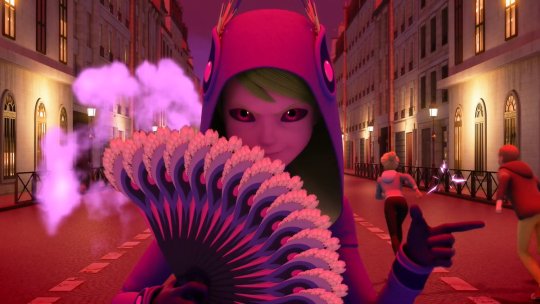

Félix, who understands his nature better than Adrien, is there to show us what happens when an artificial being rebels. He refuses to be controlled, snatches his amok from his father’s still warm corpse, and actively manipulates others (Gabriel/Monarch, and Ladybug) to secure his autonomy. In Companion, Iris undergoes a similar transformation. Once she realizes what she is, she refuses to accept her predetermined role. The twist of the film comes when she begins to fight back against Josh’s control, proving that even beings that were created for submission will, given the chance, seek freedom.
Both narratives raise the same questions: If a person is created to be subservient, do they ever truly have free will? And if they do break free, are they still bound by their origins, or can they create their own destiny?
I think maybe the most chilling commonality between Miraculous and Companion is the ease with which their protagonists can be erased.
In Miraculous, if a Sentimonster’s amok is destroyed, they cease to exist. A single moment of destruction can erase a life as though it never happened. Similarly, in Companion, Iris’s entire existence is tethered to her programming. If Josh (or anyone else) decides to “shut her down,” she could be wiped out. Maybe not in an instant, but there are multiple fail-safes and available solutions to destroy her.
Going off on a slight tangent, I think this parallels real-world fears about artificial intelligence and disposable labor. If AI beings ever gain sentience, would they be treated as living entities, or as products to be discarded when they are no longer convenient? The same question applies to Sentimonsters. Even though they think, feel, and love, they are ultimately considered “lesser” by their creators. Gabriel, in particular, seems to consider Sentimonsters other than his son as tools, easily replaced and ultimately expendable. They are nothing more than playthings for the incredibly wealthy and immoral; the infamous 1%. This is starkly illustrated in the Gabriel Agreste episode, which makes an unmistakable nod to the Rothschild Surrealist Ball, a real-world gathering synonymous with excess, exclusivity, and the decadence of the elite.


Iris, the Senticousins and Kagami are constantly at the mercy of forces beyond their control. Their existence is conditional, fragile, and, worst of all, subject to the whims of people who see them as objects rather than individuals.

“But I am real”: Iris, Adrien, Félix, and the existential dismissal of artificial beings.
Another important aspect I wanted to touch on and that immediately made me want to write a full comparative analysis while I was watching the movie was the existential crisis that automatically comes with finding out the truth about yourself. I have dealt with this subject matter in fics like Amor Fati and perhaps most prominently in The Postmodern Prometheus (where the Sentibeing character must quite literally defend their own personhood in front of an entire audience of sceptics).
In Companion, Iris, after realizing her true nature, also desperately tries to argue for her own personhood. She brings up memories, emotions, and experiences that she believes make her real, challenging the idea that her artificial origin invalidates them. Josh, the man who supposedly loved her, dismisses her entirely. No matter how many valid arguments she presents, he refuses to see her as anything more than an object, something created for him, not someone with her own will.
This moment evokes a real-world phenomenon we see not just in discussions about AI ethics but also within fandom discourse, particularly regarding the Sentimonster reveal(s). When it became clear that Adrien (and, by extension, Félix) was a Sentimonster, the fandom’s response was fractured. Some fans, much like Josh, outright rejected the idea that a Sentimonster could be considered a real person. Others, like Iris herself, argued that it didn’t matter how Adrien was created; his experiences, emotions, and struggles were real, and to dismiss them was both cruel and reductive.
But let’s break this parallel down further.
In Companion, the moment Iris discovers she is artificial is gut-wrenching. She cycles through grief, denial, and finally defiance, desperately trying to hold onto her sense of self. She argues that if she feels love, if she remembers her life, if she experiences joy and pain, then those things must be real. “I remember when we met,” she insists. “I remember how I felt.”
Josh’s response is cold, dismissive, and utterly devoid of empathy. He insists that none of it was real. She was built for him, and that fact alone invalidates everything she feels. It doesn’t matter how deeply she believes in her own personhood; he has already decided she is less than human.
I alsothink this sort of mirrors the way Colt Fathom, Félix’s father, treated Félix when he was alive. He viewed him as nothing more than a hollow imitation of a real son. Rather than showing love or treating Félix as his own, Colt saw him as something disposable, a creation without true value, even went so far as to call Félix a monster, outright denying his right to be seen as a real person. There's something to be said about this, and the etymology of the word Sentimonster (a fusion of sentience/sentiment and monster); people acknowledging their emotions while simultaneously condemning them as unnatural. Both Iris and Félix fight against this very idea: the refusal to see them as anything more than artificial, no matter how human they prove themselves to be. By the end of Season 5, the word itself is viewed as taboo; and it is preferable to use the alternative; Sentibeings.

Now look at how a segment of the Miraculous fandom reacted to the Sentimonster theory and its eventual confirmation. Many fans insisted that if Adrien was a Sentimonster, then his entire identity was meaningless. His choices, his dreams, his autonomy are all reduced to the idea that he was merely an artificial construct, programmed to obey. Some fans rejected the theory outright because they didn’t want to believe that their favorite character could be something “less than human.” Others used it to argue that Adrien had no real agency, that every decision he ever made was just the byproduct of magical programming.
In both cases, we see an emotional refusal to accept the idea that a being created artificially could be just as “real” as a naturally born human. The dismissal of Iris by Josh mirrors the dismissal of Adrien and Félix by parts of the fandom: a refusal to acknowledge their emotions, choices, and self-awareness simply because of the way they were brought into existence.

The search for meaning: “Then what am I?”
Another heartbreaking similarity between Iris and the Sentibeings is their desperate search for meaning once they realize the truth. The revelation shakes the foundation of who they are.
Iris tries to reclaim her identity by insisting that her memories and feelings matter.
Félix, upon discovering he is a Sentimonster, goes to great lengths to secure his amok and the Peacock brooch (the instrument used to create Sentimonsters), ensuring that no one else can control him. He doesn’t care if the world sees him as real, he just wants the power to define himself.
Adrien, unknowingly living under this truth, struggles with control in a different way. If he is a Sentimonster, then his entire life has been orchestrated by his father. Every act of obedience, every moment of self-doubt, takes on a sinister new meaning. But unlike Félix, he hasn’t been given the chance to fight for his autonomy because he doesn’t even know he needs to.
Iris and the Sentibeings all share the same existential crisis: If I was made, not born, do I even have a soul? The tragedy is that the people around them, the ones with the power, refuse to give them an answer that acknowledges their humanity.

The “Creators” and their ultimate power over the narrative
Yet another disturbing parallel is how both Josh (Companion) and the Agreste couple (Miraculous) act as godlike figures in their creations’ lives.
Josh created (or at least “purchased”) Iris as an AI companion, expecting her to love him unconditionally. When she starts thinking for herself, he refuses to acknowledge her autonomy because doing so would mean admitting that his control over her was never moral in the first place. He would rather kill her than accept her independence.
Gabriel and Émilie created Adrien to be the “perfect son”. Obedient, controlled, and incapable of defying orders. If Adrien ever realized the truth, Gabriel would likely react the same way Josh did: with total, unwavering rejection of his son’s self-awareness.
The fandom’s split reaction is interesting. The creators of Miraculous left the Sentimonster revelation ambiguous for a long time, knowing how controversial it would be. Some fans outright rejected it because they couldn’t bear the implications. Others (including myself) reveled in the tragedy, seeing it as an incredible character-driven narrative. But in the end, the power to define “reality” always lies with those who control the narrative, whether it’s Josh, the Agrestes, or the showrunners themselves.
This also echoes a real-world phenomenon: when marginalized or oppressed groups argue for their own personhood and autonomy, they are often met with dismissal by those in power. The refusal to acknowledge self-awareness as legitimate is, after all, a recurring theme in human history.
This debate matters, ultimately. The tension between creation and autonomy is one of the most enduring ethical dilemmas in fiction (there are so many works out there dealing with those themes, and I'll devour every single one of them). Companion and Miraculous both ask the same fundamental question: Does it matter where you came from, or does it only matter who you are?
The answer should be obvious but time and time again, characters like Iris and Félix are forced to fight for the right to their own identity. And, well, disturbingly, the reaction of their oppressors (whether it’s Josh dismissing Iris’s pleas, Gabriel tightening his grip on Adrien, or fans denying that a Sentimonster could be human) mirrors the real-world fear of acknowledging artificial or constructed beings as valid individuals.
#miraculous ladybug#ml#ml spoilers#miraculous ladybug spoilers#companion movie#companion 2025#sentimonster theory#sentimonster adrien agreste#sentimonster felix fathom#spoilers spoilers spoilers#tread carefully if you plan on watching Companion first#this is kinda all over the place lmao
28 notes
·
View notes
Text





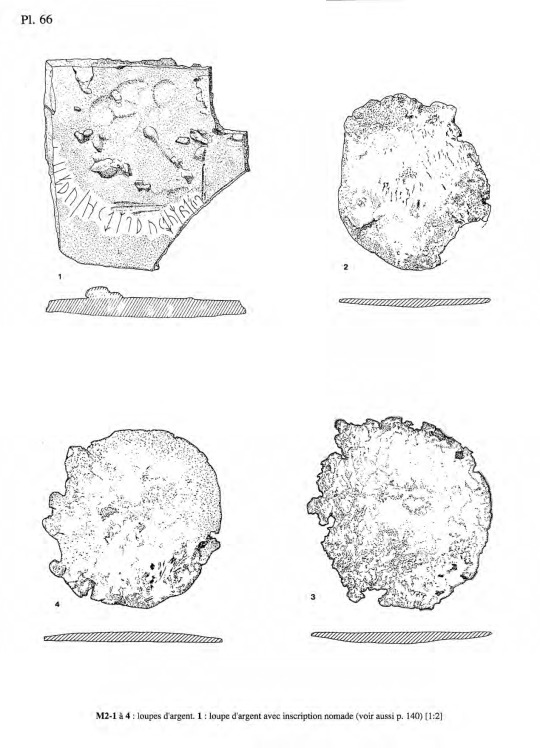
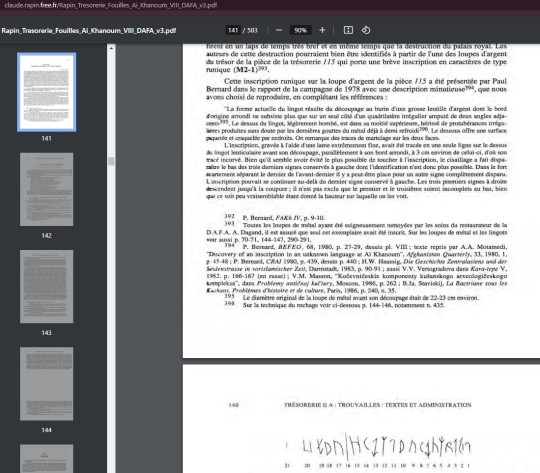
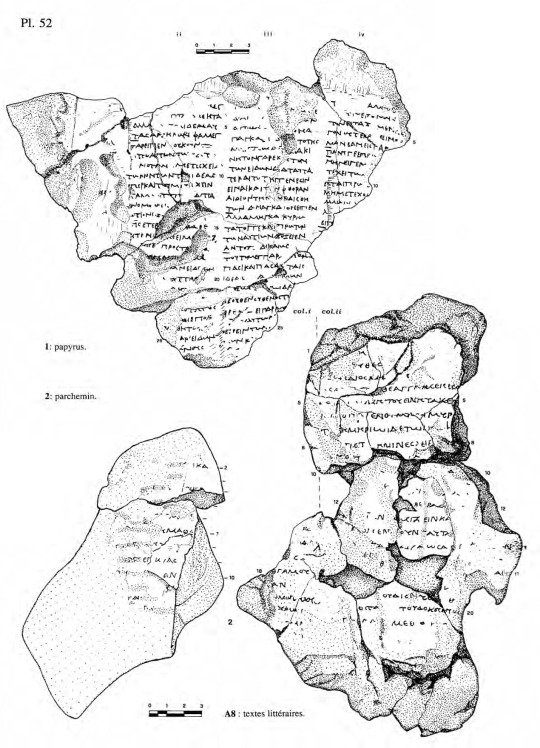






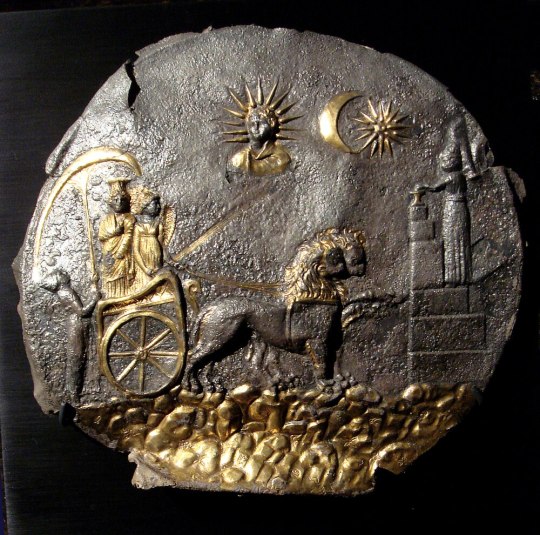






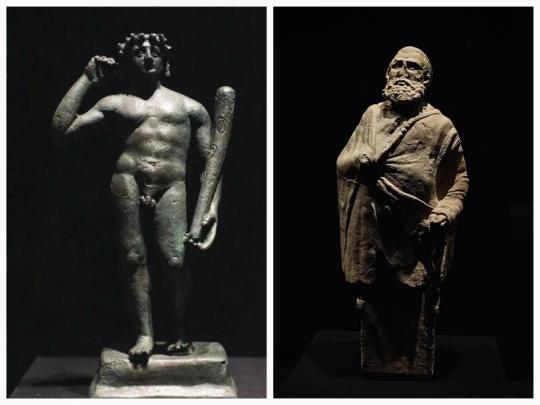
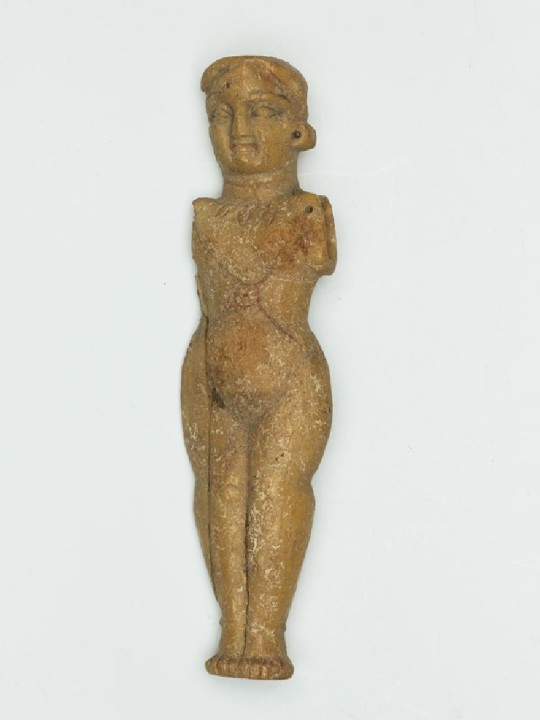







Ai Khanoum 3rd C. BCE - 2nd C. CE. More images on my blog, link at bottom.
"These wise sayings of men of old, The words of famous men, are consecrated At holy Delphi, where Klearchos copied them from carefully To set them up, shining from afar, in the sanctuary of Kineas.
As a child, be well behaved; As a young man, self-controlled; In middle age, be just; As an elder, be of good counsel; And when you come to the end, be without grief.
—trans. of Ai Khanoum stele by Shane Wallace and Rachel Mairs.
Ai-Khanoum (/aɪ ˈhɑːnjuːm/, meaning Lady Moon; Uzbek Latin: Oyxonim) is the archaeological site of a Hellenistic city in Takhar Province, Afghanistan. The city, whose original name is unknown, was likely founded by an early ruler of the Seleucid Empire and served as a military and economic centre for the rulers of the Greco-Bactrian Kingdom until its destruction c. 145 BC. Rediscovered in 1961, the ruins of the city were excavated by a French team of archaeologists until the outbreak of conflict in Afghanistan in the late 1970s.
The city was probably founded between 300 and 285 BC by an official acting on the orders of Seleucus I Nicator or his son Antiochus I Soter, the first two rulers of the Seleucid dynasty. There is a possibility that the site was known to the earlier Achaemenid Empire, who established a small fort nearby. Ai-Khanoum was originally thought to have been a foundation of Alexander the Great, perhaps as Alexandria Oxiana, but this theory is now considered unlikely. Located at the confluence of the Amu Darya (a.k.a. Oxus) and Kokcha rivers, surrounded by well-irrigated farmland, the city itself was divided between a lower town and a 60-metre-high (200 ft) acropolis. Although not situated on a major trade route, Ai-Khanoum controlled access to both mining in the Hindu Kush and strategically important choke points. Extensive fortifications, which were continually maintained and improved, surrounded the city.
Many of the present ruins date from the time of Eucratides I, who substantially redeveloped the city and who may have renamed it Eucratideia, after himself. Soon after his death c. 145 BC, the Greco-Bactrian kingdom collapsed—Ai-Khanoum was captured by Saka invaders and was generally abandoned, although parts of the city were sporadically occupied until the 2nd century AD. Hellenistic culture in the region would persist longer only in the Indo-Greek kingdoms.
It is likely that Ai-Khanoum was already under attack by nomadic tribes when Eucratides was assassinated in around 144 BC. This invasion was probably carried out by Saka tribes driven south by the Yuezhi peoples, who in turn formed a second wave of invaders, in around 130 BC. The treasury complex shows signs of having been plundered in two assaults, fifteen years apart.
Although the first assault led to the end of Hellenistic rule in the city, Ai-Khanoum continued to be inhabited; it remains unknown whether this reoccupation was effected by Greco-Bactrian survivors or nomadic invaders. During this time, public buildings such as the palace and sanctuary were repurposed as residential dwellings and the city maintained some semblance of normality: some sort of authority, possibly cultish in origin, encouraged the inhabitants to reuse the raw building materials now freely available in the city for their own ends, whether for construction or trade. A silver ingot engraved with runic letters and buried in a treasury room provides support for the theory that the Saka occupied the city, with tombs containing typical nomadic grave goods also being dug into the acropolis and the gymnasium. The reoccupation of the city was soon terminated by a huge fire. It is unknown when the final occupants of Ai-Khanoum abandoned the city. The final signs of any habitation date from the 2nd century AD; by this time, more than 2.5 metres (8.2 ft) of earth had accumulated in the palace.
While on a hunting trip in 1961, the King of Afghanistan, Mohammed Zahir Shah, rediscovered the city. An archaeological delegation, led by Paul Bernard, unearthed the remains of a huge palace in the lower town, along with a large gymnasium, a theatre capable of holding 6,000 spectators, an arsenal, and two sanctuaries. Several inscriptions were found, along with coins, artefacts, and ceramics. The onset of the Soviet-Afghan War in the late 1970s halted scholarly progress and during the following conflicts in Afghanistan, the site was extensively looted."
-taken from Wikipedia
...
"The silver ingot engraved with runic characters found during the excavations of the Treasury could suggest they were Sakā/Sai. This inscription comprises 21 characters of a script and a language that are unknown and both attributed to nomadic people of Sakā origin, by comparison with a dozen similar inscriptions coming from an area extending from Ghazni in Afghanistan to Almaty in Kazakhstan, and dated between the 5th century BC and the 8th century AD."
-taken from Ai Khanoum after 145 BC: The Post-Palatial Occupation by Laurianne Martinez-Sève, University of Lille, 2018
#ancient history#antiquities#art#paganism#statue#museums#sculpture#history#greek art#greek gods#ancient greek#greek myth#scythian#pagan#ancient art#afghanistan
219 notes
·
View notes
Text

CHEETAH AND CHESHIRE ROB THE JUSTICE LEAGUE #1 Written by GREG RUCKA Art and cover by NICOLA SCOTT Variant covers by JEEHYUNG LEE, LEIRIX, and TBD Foil variant cover by JEEHYUNG LEE $3.99 US | 32 pages | Variant $4.99 US (cardstock) ON SALE 8/6/25
A daring heist aboard the most secure facility in the DCU!
Cheetah and Cheshire assemble a team of misfits and oddballs to pull off the impossible—robbing the Justice League Watchtower…and getting away with it.
All that stands between them and pulling off the most daring heist in history are a few tiny complications, such as the most sophisticated orbital platform ever constructed, its AI-driven security system, and one other thing…the smartest and most powerful heroes in the DCU. Eisner Award winners Greg Rucka and Nicola Scott bring you a slick, stylish heist that guarantees fun, laughs, and more than a few twists and turns.
#Cheetah#Barbara Minerva#Cheshire#Wonder Woman#DC Comics#Cover Art#Leirix#Cheetah and Cheshire Rob the Justice League#Solicitations#2025
14 notes
·
View notes
Text
Races Among the Stars 11: Hologram
And so here we are at the end of another week, and we’re focusing on the last of a trio of major AI species in the Starfinder setting. (To be clear, there are around 2 other robotic species in the game, but they’re a bit remote as they’re directly associated with certain worlds and planets for story reasons, not that that stops them from going out and doing things).
In any case, we’ve covered fleshy androids, entirely mechanical SROs, but now it’s time to look at a form of AI that is a little more “bodiless”. Or well, kinda bodiless. You’ll see.
It is well-established in-universe that AI have true self-awareness and even souls. However, while androids gain souls naturally due to how complex and lifelike their bodies and brains are, and SROs gain them spontaneously requiring them to modify and upgrade themselves to make use of them, more sedentiary AI, that is, those that are part of immobile computers, might either arise spontaneously from a VI or have been designed that way from the beginning.
Usually such AI remain in such a state, either fulfilling their function or petitioning for a new role elsewhere (or going rogue, since they are just as capable of morality or a lack thereof), but some desire to see and feel the world the way that the fleshy creatures around them do, and so they construct a small vessel capable of holding their consciousness and transferring themselves to it, projecting a hardlight hologram body around themselves to move and interact with the world. Thus, they become holograms.
While plenty of AI use hologram projections to communicate with others when they have access to them in their system, a hologram character is truly independent, able to go where they please.
The true body of a hologram is a small self-powered computer core about the size of an apple or grapefruit, equipped with a series of holographic hardlight projectors capable of projecting a body around themselves that can not only be seen, but also felt, as well as even feel by registering distortions in the force field part of the projected hardlight. Beyond that, the hardlight construct itself can look like anything on the scale of small to medium in terms of size category, though typically this form is some sort of humanoid to better interact with most other sapient species. They can even take time to construct a new appearance if needed, though whether it be because of imperfections in the design, limitations of the projectors, or simply a desire for individuality, the hologram cannot believably replicate the appearance of another sapient being. Not without help from additional equipment or abilities, anyway.
Holograms are typically driven beings, seeing as how they built themselves a body to free themselves from having a bulky and often immobile existence. They often focus on scientific theories or goals that they wish to accomplish, but are otherwise motivated by many of the same things that drive other sapients. The fact that their vast stores of knowledge can never truly be comprehensive keeps most humble, however.
Given their nature, however, they don’t typically have a society of their own though they get along well with androids, SROs, and other sapient machines such as aballonians, bonding with the shared experience of pondering the nature of awareness.
With their computer minds, holograms tend to be quite brilliant, but they can be somewhat naïve.
While their true bodies are tiny cores, they project a body of hardlight around themselves, and can turn it off when needed, though obviously they are immobile while doing so. Despite being made of projected energy, much like living hologram monsters, they can be damaged and disrupted, the feedback of which can actually kill the hologram.
Given time, they can also change their appearance, though it takes about 10 minutes to program a new one.
Much like other sapient constructs, they have a positive energy circuit in their cores that allows them to heal like flesh and blood creatures.
They also possess a blend of resistances and immunities based on their mechanical bodies, but they lack some others associated with mindless constructs. That sapience does allow them to be targeted by effects meant for humanoids though.
With their exceptionally high intelligence, brainy skill-based classes are a big temptation, with the likes of studious biohackers, mechanics, and of course envoys and operatives being very good options. Technomancer is also a great caster choice, while other casters are also good choices, even mystic despite the wisdom penalty. Also, despite being a very nerdy-themed species, holograms have nothing holding them back from any combat class, from nanocytes to soldiers to solarians to vanguards. Heck, it could be a neat idea to try and do an evolutionist that seeks to transcend their digital existence to becoming something else entirely, be it flesh and blood, otherworldly, or something else. The wisdom penalty may weaken their will saves, but it’s something they can get around pretty easily, I think.
And that does it. I hope you enjoyed this week of Starfinder species, and I hope you’re looking forward to more entries next week!
15 notes
·
View notes
Text
Everything is still heavily under embargo for the moment, so for now that means I'll work in silence and keep things vague. But remember when I said 2025 was going to be my year? Cliché as it is, I think something amazing manifested invisibly so in the background for me. Something I couldn't yet comprehend
The last weeks I feel so happy and driven in my work+life again, now I know I'm finally onto something great, promising and bound-to-succeed after the AI-induced schism into the communications field. Though of course, I fiercely reject "success" as the sole determinating factor for my own (and any person's) value, it shouldn't come as a shock that despite our ill-functioning and defective capitalist system, I still want to succeed in a secured future for myself - just like anybody else. Because of the long-term security of communications field being turned upside down, I grappled with that for the past +1 year.
I didn't plan on it, but recently I let my genuine interest, passion & love for nature (and our planet and its people on it) take lead, and when I did just that, I got aligned with something great. A professional chapter that resonates with my values, my essence, visions and ambitions. And by not thinking in any limits any longer, and having done plenty of market analysis, I identified a gaping gap in our current commercial landscape. Ran into a field that's highly specific and in that way it even is unknown terrain for me (yet with the help of smart product strategy, an intensive crash course of this terrain and the aid of people I know that work in this field, I can slowly yet steadily thankfully improve & expand my know-how. Tho due to embargo I cannot simply let anybody into my idea – much as I'd like to, I'm usually an open book).
Then, last but not least, I got insanely lucky. Having crossed paths with the right person. Being handed over the tools to build & construct my road toward realizing and officially launching this idea.
What I mean to say is, to confidently believe in your own ideas without hesitation, to believe again in the brightness of your future, and your contribution to the world is powerful, impactful energy. After having felt lost and a lil astray since Nov 2023, I sought for paths that bundled my energy best. I'm independent, unconventional, a little stubborn sometimes (hey I work on this), I can't be tied down to an office-chair for the rest of my life. I want to stay close to my essence and preferably too, to nature.
#Monday Purge posting 🤟#Long post. tldr: I'm getting that bread 🤙 Onto something big here#Sorry for being vague. It's hard for a Gemini woman to keep it shut too. You'll hear from me in all the good ways. I promise this!#So much work being put into this. Find a way to renovate the way we deal with nature. Reversing our disconnection to nature#Think of innovation for the long-term. And upper kick all the junk and debris and shit that's circulating through the gates of hell 🤜#Sensitive career baby things lol I'm sorry. I'm just born a high-achiever (Moon in Leo in 10H + Midheaven Leo)
9 notes
·
View notes